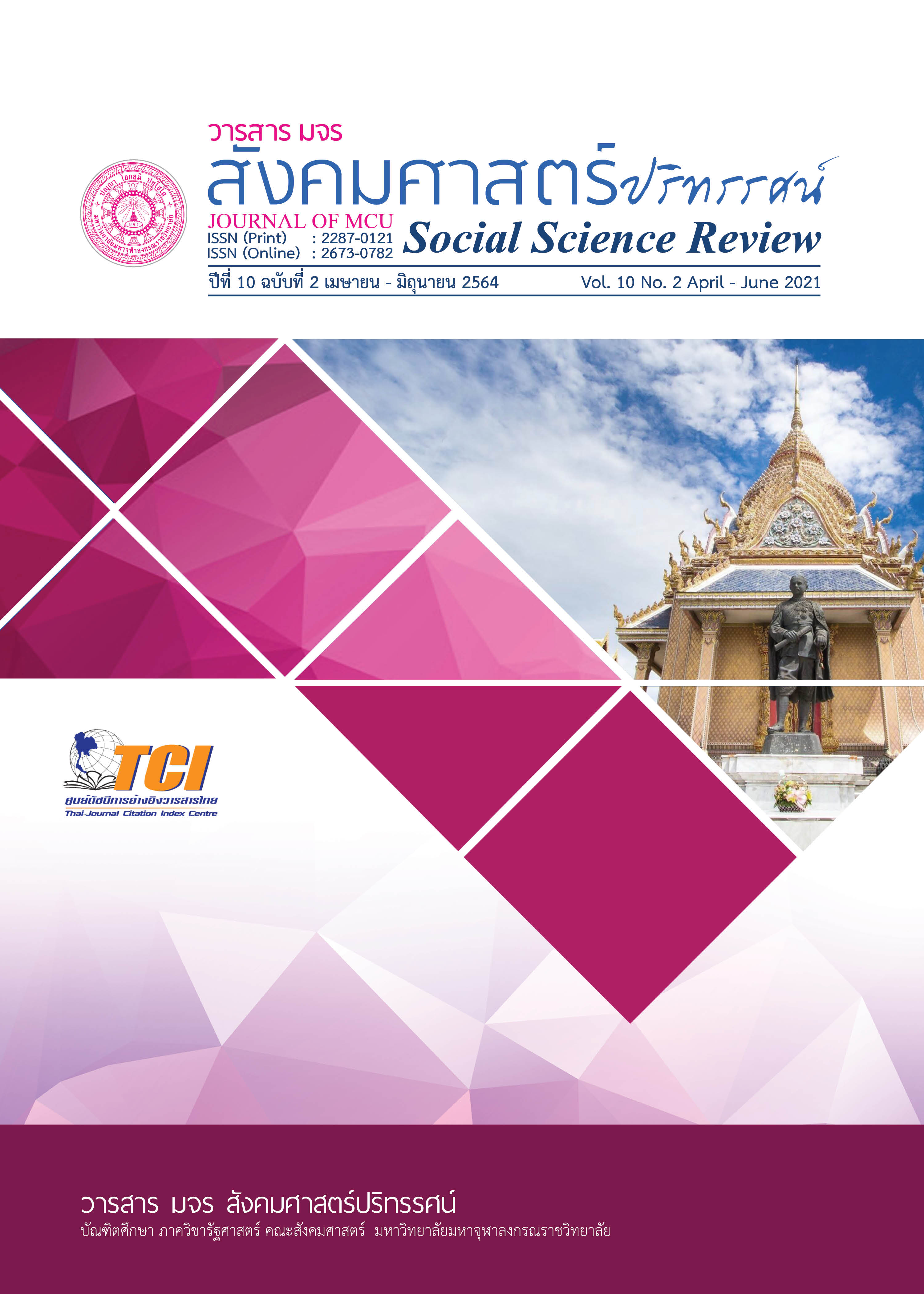พุทธธรรมาภิบาลเพื่อพัฒนาประสิทธิภาพการปฏิบัติงาน ของบุคลากรเทศบาลในจังหวัดสระแก้ว
คำสำคัญ:
พุทธธรรมาภิบาล, ประสิทธิภาพ, การปฏิบัติงานบทคัดย่อ
บทความวิจัยนี้มีวัตถุประสงค์เพื่อ 1. ศึกษาประสิทธิภาพการปฏิบัติงานของบุคลากร
2. ศึกษาปัจจัยที่ส่งผลต่อประสิทธิภาพการปฏิบัติงานของบุคลากร 3. นำเสนอรูปแบบพุทธ
ธรรมาภิบาลเพื่อพัฒนาประสิทธิภาพการปฏิบัติงานของบุคลากรเทศบาลในจังหวัดสระแก้ว รูปแบบการวิจัยเป็นแบบผสานวิธี การวิจัยเชิงปริมาณใช้แบบสอบถาม เก็บข้อมูลจากกลุ่มตัวอย่าง จำนวน 450 คน วิเคราะห์ข้อมูลด้วยโปรแกรมสำเร็จรูปทางสังคมศาสตร์ การวิจัยเชิงคุณภาพใช้วิธีการสัมภาษณ์เชิงลึกกับผู้ให้ข้อมูลสำคัญ จำนวน 17 รูปหรือคน และการสนทนากลุ่มเฉพาะจำนวน 10 รูปหรือคน วิเคราะห์ข้อมูลโดยการวิเคราะห์เนื้อหาเชิงพรรณนา
ผลการวิจัยพบว่า 1. ประสิทธิภาพการปฏิบัติงานของบุคลากรโดยภาพรวมและรายด้านประกอบด้วย การมุ่งผลสัมฤทธิ์ การยึดมั่นในความถูกต้อง ความเข้าใจในระบบองค์กรและระบบงาน การบริการที่เป็นเลิศและการทำงานเป็นทีม อยู่ในระดับมาก 2. ปัจจัยที่ส่งผลต่อประสิทธิภาพการปฏิบัติงานของบุคลากร พบว่า การพัฒนาสมรรถนะบุคลากรและปัจจัยการปฏิบัติงานตามหลัก 7S ผ่านหลักพละ 4 ส่งผลต่อประสิทธิภาพการปฏิบัติงานของบุคลากรร้อยละ 104 และ 3. รูปแบบพุทธธรรมาภิบาลเพื่อการพัฒนาประสิทธิภาพการปฏิบัติงานของบุคลากร พบว่า ประสิทธิภาพการปฏิบัติงานมีปัจจัยพื้นฐาน 2 อย่าง คือ ปัจจัยการปฏิบัติงานตามหลัก 7S และการพัฒนาสมรรถนะของบุคลากร โดยบูรณาการหลักพุทธธรรมาภิบาลคือหลักพละ 4 ได้แก่ 1) ปัญญาพละ (กำลังความรู้) 2) วิริยพละ (นำสู่การปฏิบัติ) 3) อนวัชชพละ (ซื่อสัตย์สุจริต) และ 4) สังคหพละ (มีจิตอาสา)
เอกสารอ้างอิง
เทศบาลจังหวัดสระแก้ว. โครงสร้างองค์กรปกครองท้องถิ่นในจังหวัดสระแก้ว. สืบค้น 18 มกราคม 2564, จาก http://cld.drr.go.th/_cld_attach/KNOWLEDGE/
/doc/736
จิดาภา เร่งมีศรีสุข. (2562). ยุทธศาสตร์เพื่อการเสริมสร้าง การมีส่วนร่วมในการส่งเสริมความโปร่งใสขององค์กรปกครองส่วนท้องถิ่นไทยในทศวรรษหน้า. วารสารการบริหารท้องถิ่น. 12 (2), 234-241.
ณรัฐ สวาสดิ์รัตน์. (2558). รูปแบบการพัฒนาศักยภาพการปฏิบัติงานของอาสาสมัครทหารพรานในจังหวัดชายแดนภาคใต้ตามหลักพุทธธรรม (วิทยานิพนธ์ปริญญาพุทธศาสตรดุษฎีบัณฑิต สาขาวิชารัฐประศาสนศาสตร์). พระนครศรีอยุธยา: มหาวิทยาลัยมหาจุฬาลงกรณราชวิทยาลัย.
ตุลา มหาสุธานนท์. (2545). หลักการจัดการ หลักการบริหาร. กรุงเทพฯ: ธนธัชการพิมพ์.
ปฐม มณีโรจน์. (2554). สาธารณคดี ภาครัฐในมุมมองนักกฎหมายการเมืองและการบริหาร, กรุงเทพฯ: สุภาภรณ์การพิมพ์.
ผดุง วรรณทอง และคณะ. (2561). การประยุกต์ใช้หลักอิทธิบาท 4 ในการบริหารองค์กรเอกชนในจังหวัดนนทบุรี. วารสาร มจร สังคมศาสตร์ปริทรรศน์, 7 (2), 99-100.
พระพรหมคุณาภรณ์ (ป.อ.ปยุตโต). (2551). พจนานุกรมพุทธศาสตร์ฉบับประมวลธรรม. กรุงเทพฯ: บริษัท เอส. อาร์. ปริ้นติ้งแมส โปรดักส์ จำกัด.
มหาวิทยาลัยมหาจุฬาลงกรณราชวิทยาลัย. (2539). พระไตรปิฎกภาษาไทย ฉบับมหาจุฬาลงกรณราชวิทยาลัย. กรุงเทพฯ: โรงพิมพ์มหาวิทยาลัยมหาจุฬาลงกรณราชวิทยาลัย.
วาสิตา เกิดผล ประสพศักดิ์. (2557). แบบจำลองการบริหารเชิงพุทธบูรณาการขององค์กรปกครองส่วนท้องถิ่น (วิทยานิพนธ์ปริญญาพุทธศาสตรดุษฎีบัณฑิต สาขาวิชารัฐประศาสนศาสตร์). พระนครศรีอยุธยา: มหาวิทยาลัยมหาจุฬาลงกรณราชวิทยาลัย.
วิกิพีเดีย สารานุกรมเสรี. (2563). การปกครองส่วนท้องถิ่น. สืบค้น 18 มกราคม 2563,
สมคิด เลิศไพฑูรย์. (2562). โครงการศึกษาวิเคราะห์และประเมินผลการถ่ายโอนภารกิจงานวาง/ปรับปรุงผังเมืองรวมเมือง/ชุมชน. สืบค้น 15 มกราคม 2563, จาก http://eservices.dpt.go.th/eservice_1/subsites/other/subcsp/index.html
ดาวน์โหลด
เผยแพร่แล้ว
รูปแบบการอ้างอิง
ฉบับ
ประเภทบทความ
สัญญาอนุญาต
ลิขสิทธิ์ (c) 2021 วารสาร มจร สังคมศาสตร์ปริทรรศน์

อนุญาตภายใต้เงื่อนไข Creative Commons Attribution-NonCommercial-NoDerivatives 4.0 International License.
เพื่อให้เป็นไปตามกฎหมายลิขสิทธิ์ ผู้นิพนธ์ทุกท่านต้องลงลายมือชื่อในแบบฟอร์มใบมอบลิขสิทธิ์บทความให้แก่วารสารฯ พร้อมกับบทความต้นฉบับที่ได้แก้ไขครั้งสุดท้าย นอกจากนี้ ผู้นิพนธ์ทุกท่านต้องยืนยันว่าบทความต้นฉบับที่ส่งมาตีพิมพ์นั้น ได้ส่งมาตีพิมพ์เฉพาะในวารสาร มจร สังคมศาสตร์ปริทรรศน์ เพียงแห่งเดียวเท่านั้น หากมีการใช้ภาพหรือตารางหรือเนื้อหาอื่นๆ ของผู้นิพนธ์อื่นที่ปรากฏในสิ่งตีพิมพ์อื่นมาแล้ว ผู้นิพนธ์ต้องขออนุญาตเจ้าของลิขสิทธิ์ก่อน พร้อมทั้งแสดงหนังสือที่ได้รับการยินยอมต่อบรรณาธิการ ก่อนที่บทความจะได้รับการตีพิมพ์ หากไม่เป็นไปตามข้อกำหนดเบื้องต้น ทางวารสารจะถอดบทความของท่านออกโดยไม่มีข้อยกเว้นใดๆ ทั้งสิ้น





